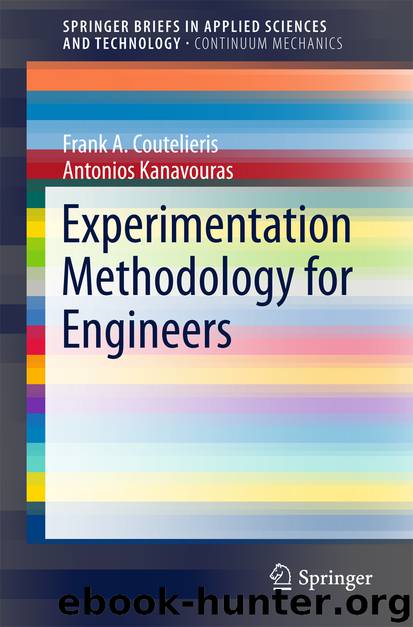Experimentation Methodology for Engineers by Frank A. Coutelieris & Antonios Kanavouras

Author:Frank A. Coutelieris & Antonios Kanavouras
Language: eng
Format: epub
Publisher: Springer International Publishing, Cham
Data
Data collection and analysis, sets off the cycle of understanding . Further unfold of experimentation , connected to the parallel unfold of knowledge and hence, understanding of nature , constitutes the cycle of understanding anticipation, containing normative implications for research. For a hermeneutic circularity, the knowledge of the phenomena and thus the formation of knowledge, implies that it is the ‘anomalous’ details within a phenomenon that, when integrated, provide a coherent, meaningful entity of the world of phenomena. The apparent “anomalies ” have still to be identified, collected and analyzed at the level of data collection, via a repeated sequence of reproducing experimental “devices”. With hermeneutic theories in need of being empirically adequate, scientists should make significant and accountable choices for a human accomplishment within the semiotic domain. This truth construction accommodates the characteristics of the phenomenal world but is not determined by them (Schultz 1965; Weber 1974).
Whatever operations are performed for gathering information about people or objects of interest in a study, some trace of what is detected must have been captured and recorded. All the traces together are called “data”. In natural sciences, data are coming from the empirical experiences of the researchers, either via direct or most of the times indirect means, tools and equipment . That is in particular, called raw data, even though if it is very frequently the outcome of a software or other type of treatment applied on the analysis experienced in regard to a phenomenon taking place during the experiment . A further process of the raw data may be required in order to closely approach, form or imply an answer to the initial question. It could as well be that the selected treatment of the raw data is selected in order to best fit and provide a pre-set opinion, point or objective of the researcher, concluding on a certainly biased outcome, remark and conclusion. Then, it is also possible that treated data requires an additional writing skill which as mentioned already could be expressed and interpreted on an individual base, yet alone that the individuals collecting the data may be different from those analyzing it and even writing about it.
In that process , the deep understanding and appreciation of the theory supporting and defining the analytical equipment, the technology impact on the handling and outcome of the resulted values and the human factor itself, need to be considered as significant factors of data collection and analysis. It is in total, an additional matter of trust and confidence regarding the manipulation and inspection of raw data to become processed, (most often statistically) analyzed and reveling. Furthermore, data rarely tells a simple univocal story, and this should not come as a surprise! With this in mind, the question regarding the quality of data collected and its truthful reflection of the phenomena intended to be examined, follow each and every single experimentation /data collection methodology.
Starting from these findings, one may wonder how to situate them in the context of existing knowledge outside the typological
Download
This site does not store any files on its server. We only index and link to content provided by other sites. Please contact the content providers to delete copyright contents if any and email us, we'll remove relevant links or contents immediately.
Algorithms of the Intelligent Web by Haralambos Marmanis;Dmitry Babenko(8522)
Test-Driven Development with Java by Alan Mellor(7411)
Data Augmentation with Python by Duc Haba(7303)
Principles of Data Fabric by Sonia Mezzetta(7053)
Learn Blender Simulations the Right Way by Stephen Pearson(6989)
Microservices with Spring Boot 3 and Spring Cloud by Magnus Larsson(6809)
RPA Solution Architect's Handbook by Sachin Sahgal(6222)
Hadoop in Practice by Alex Holmes(6031)
The Infinite Retina by Robert Scoble Irena Cronin(5921)
Jquery UI in Action : Master the concepts Of Jquery UI: A Step By Step Approach by ANMOL GOYAL(5873)
Big Data Analysis with Python by Ivan Marin(5721)
Life 3.0: Being Human in the Age of Artificial Intelligence by Tegmark Max(5403)
Pretrain Vision and Large Language Models in Python by Emily Webber(4686)
Infrastructure as Code for Beginners by Russ McKendrick(4464)
WordPress Plugin Development Cookbook by Yannick Lefebvre(4196)
Functional Programming in JavaScript by Mantyla Dan(4124)
The Age of Surveillance Capitalism by Shoshana Zuboff(4116)
Embracing Microservices Design by Ovais Mehboob Ahmed Khan Nabil Siddiqui and Timothy Oleson(3983)
Applied Machine Learning for Healthcare and Life Sciences Using AWS by Ujjwal Ratan(3961)
